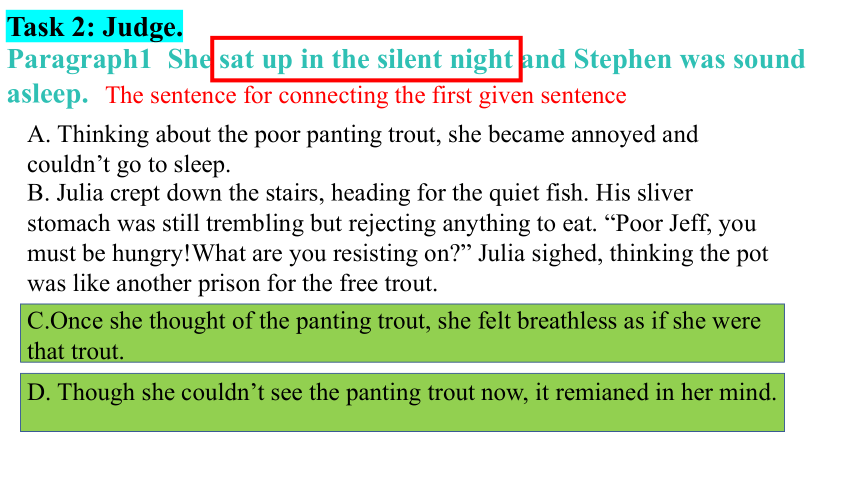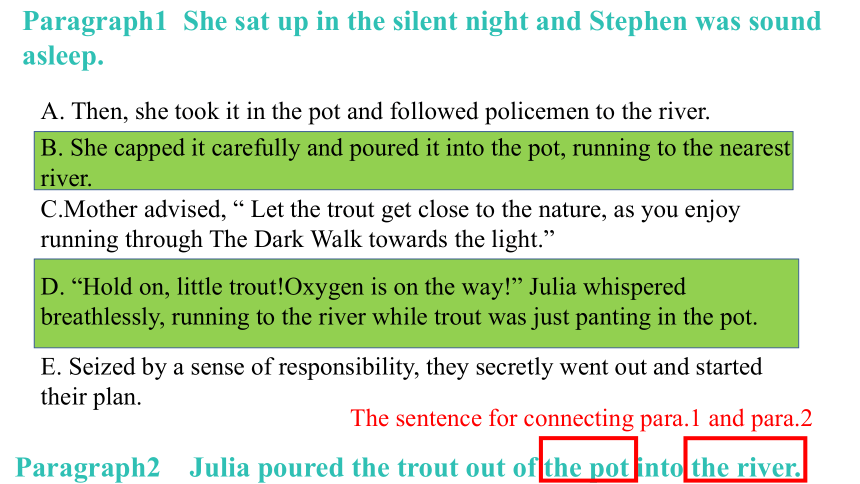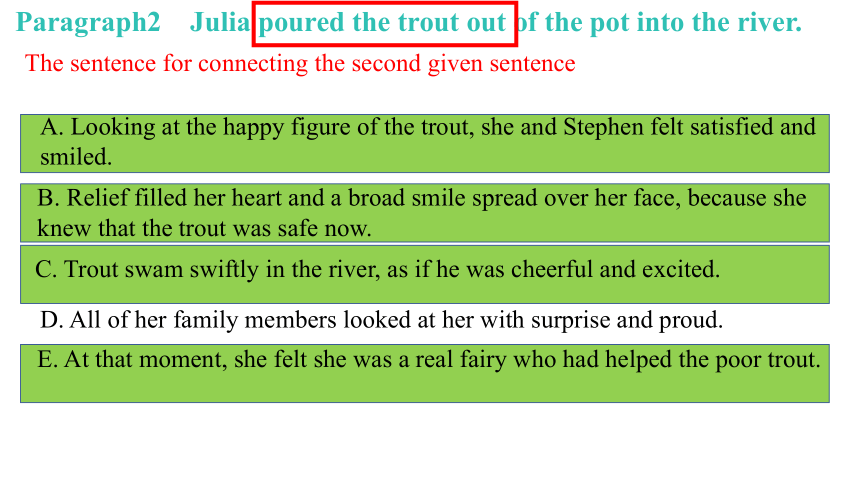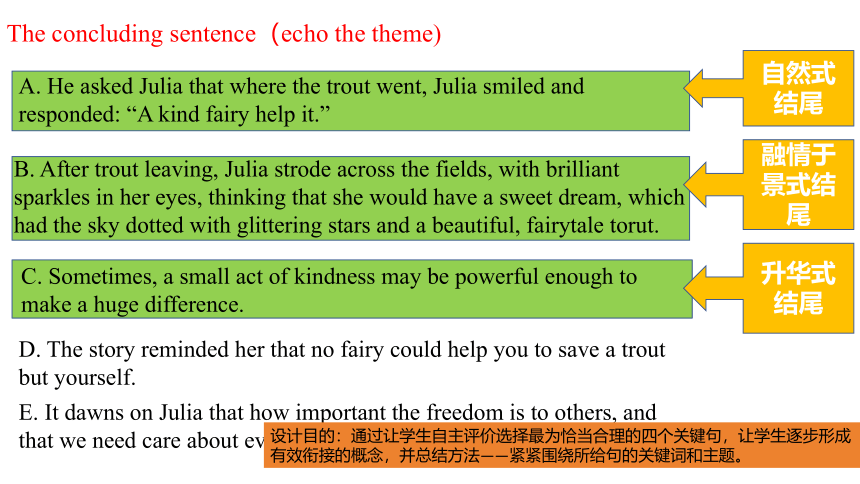2025届高考英语“学为中心”的读后读写写作指导课件(共20张PPT)
文档属性
| 名称 | 2025届高考英语“学为中心”的读后读写写作指导课件(共20张PPT) |  | |
| 格式 | pptx | ||
| 文件大小 | 3.0MB | ||
| 资源类型 | 教案 | ||
| 版本资源 | 通用版 | ||
| 科目 | 英语 | ||
| 更新时间 | 2024-09-19 09:50:07 | ||
图片预览









文档简介
(共20张PPT)
“学为中心”的读后续写写作指导
“学为中心”的理论依据
一、人的全面发展——课堂教学的教育底色;
二、人本主义——课堂教学的生命主张;
三、建构主义——课堂教学的实践旨向;
四、多元智能——课堂教学的评量尺度。
其中,建构主义认为
1.知识不是客观世界的映像,而是个体经验的生成
2.学习是引导学生主动建构的活动
3.教学是师生之间的合作性建构
以学为中心的教学
就是在教学过程中教师发挥引导作用,提供必要的
学习支持,发挥学生的主观能动性,使其在课内外
主动积极学习、自我进行学习建构,实现全面发展。
“学为中心的教学”,其核心是通过探究问题、解决问题的学习方式,提升学生的自主学习和创新能力。
1 . 关 注 学 情 分析 , 从 学 生视 角 进行设 计
“学为中心”的教学设计应在充分了解学生已有的知识和经验、思维过程和知识表征方式的基础上,站在学生的视角设计教学,关注学生的兴趣所在,研究学生的学习难点和易错之处,设计学生思维活动能够真实展开的问题情境和探究方式,选择最合适学生学习路径的教学策略,引导学生在最近发展区完成核心素养的提升。
如:测试后,根据评阅分析,发现学生在续写中呈现的集中性的主要问题为四个关键句的衔接问题, 这四个句子分别是衔接第一段开头句的句子,第一段的尾句,衔接第二段开头句的句子和全文尾句,并以此作为教学的起点。
学情分析是“学为中心”教学设计的基础。
一切为了学生
“学为中心”的读后续写写作指导设计将“学为 中 心”的理念贯穿 于教学设计的主要环节 。
Paragraph1 She sat up in the silent night and Stephen was sound asleep.
A. Thinking about the poor panting trout, she became annoyed and couldn’t go to sleep.
The sentence for connecting the first given sentence
B. Julia crept down the stairs, heading for the quiet fish. His sliver stomach was still trembling but rejecting anything to eat. “Poor Jeff, you must be hungry!What are you resisting on ” Julia sighed, thinking the pot was like another prison for the free trout.
C.Once she thought of the panting trout, she felt breathless as if she were that trout.
D. Though she couldn’t see the panting trout now, it remianed in her mind.
Task 2: Judge.
Paragraph1 She sat up in the silent night and Stephen was sound asleep.
Paragraph2 Julia poured the trout out of the pot into the river.
The sentence for connecting para.1 and para.2
B. She capped it carefully and poured it into the pot, running to the nearest river.
C.Mother advised, “ Let the trout get close to the nature, as you enjoy running through The Dark Walk towards the light.”
D. “Hold on, little trout!Oxygen is on the way!” Julia whispered breathlessly, running to the river while trout was just panting in the pot.
E. Seized by a sense of responsibility, they secretly went out and started their plan.
A. Then, she took it in the pot and followed policemen to the river.
Paragraph2 Julia poured the trout out of the pot into the river.
The sentence for connecting the second given sentence
A. Looking at the happy figure of the trout, she and Stephen felt satisfied and smiled.
B. Relief filled her heart and a broad smile spread over her face, because she knew that the trout was safe now.
C. Trout swam swiftly in the river, as if he was cheerful and excited.
D. All of her family members looked at her with surprise and proud.
E. At that moment, she felt she was a real fairy who had helped the poor trout.
The concluding sentence(echo the theme)
A. He asked Julia that where the trout went, Julia smiled and responded: “A kind fairy help it.”
C. Sometimes, a small act of kindness may be powerful enough to make a huge difference.
B. After trout leaving, Julia strode across the fields, with brilliant sparkles in her eyes, thinking that she would have a sweet dream, which had the sky dotted with glittering stars and a beautiful, fairytale torut.
D. The story reminded her that no fairy could help you to save a trout but yourself.
E. It dawns on Julia that how important the freedom is to others, and that we need care about every life’s feeling.
自然式结尾
融情于景式结尾
升华式结尾
设计目的:通过让学生自主评价选择最为恰当合理的四个关键句,让学生逐步形成有效衔接的概念,并总结方法——紧紧围绕所给句的关键词和主题。
为了学生的一切
2.重视整体设计,关注学生学习的整体性
教学设计坚持以全面反映学生在课堂上的一切学习情况为原则。学习情况并不是单指学生对于某道题目或教师提出的某个问题的回答正确与否,还指在整个课堂学习过程中学生的交流与互动。强调学习主体、学习条件、学习结果的整体表达,强调学习行为到学习评估的整个过程,强调学习行为的可视化和学习结果的可检测、易评估。因此在设计中,通过搭建支架,指导高通路,可迁移的学习策略,坚持以个别抽样作答和小组讨论作答为主要呈现方式。
Task 1: Evaluate.
Principle 1: Action— Response
Principle 2: Conflict—Solution
Principle 3: Negative—Positive
“3Ps”
Continuation
too general
Action— Response
设计目的:指导学生关注在续写中的高通路的、可迁移的三大原则,小组据此讨论评判,发现问题,即角色A的所言、所行、所感、所想会引起其他角色的一系列反应。从而突出体现在整个课堂学习过程中学生的交流与互动。该设计整体表达学习主体、学习条件、学习结果,呈现了学习行为到学习评估的整个过程,其中的学习行为是可视化的和学习结果也是可检测、易评估的。
为了一切学生
3.全方位收集每一位学生的学习情况
课前根据学生的作业反馈情况分析学情,课中关注每位学生的反应,和小组讨论情况,以更好更全面的获得学生学习知识的信息和同伴交往的信息。课后每位学生提交作业,教师及时反馈评价。
Group 1: Andy’s idea
A
B
Which of the following version better shows the difference brought by the idea Why
excited Andy
changed greatly
Task 2: Judge.
Tip1:Adding the specific description of what the character felt and did to shape the character better.
设计目的:基于对学生考试情况的分析,找准学生的问题——没能基于人物特点,恰当描述人物情绪和动作行为,未能基于语境恰当描述人物情绪,人物形象塑造与前文脱节等。通过在学生作品中节选值得学习的和有待改进的案例,让学生在对比分析和讨论中,总结出恰当的技巧。之后改写提升,迁移运用。充分体现为了一切学生
Read the rest excerpts (节选) and discuss in groups:
Which version in group 2 better shows Andy's excitement
Which version in group 3 better describes Andy’s interaction with Mr. Crane
Which version in group 4 better reveals the theme
Group 2: Andy’s excitement
A
B
Which of the following version better shows Andy’s excitement Why
By using the writing method of exclamatory sentence and the rhetorical device---simile , more intense emotion could be shown.
Group 3: Andy’s interaction with Mr.Crane
A
B
Which of the following version better describes Andy’s interaction with Mr. Crane Why
Tip3: The characterization(人物刻画) should be consistent with the original and reasonable.
Group 4: Andy’s reflection
A
B
Which of the following version better reveals the theme Why
Choose one of the following contents, rewrite your own version.
Group 1: The difference brought by Andy’s idea (specific description of what the character felt and did)
Group 2: Andy’s excitement (exclamatory sentence and the rhetorical device)
Group 3: Andy’s interaction with Mr Crane (showing characters’ consistent personalities)
Group 4: Andy’s reflection (revealing the theme)
Task 3: Rewrite.
我们可以发现:
在”学为中心”的课堂中,教师通过采用问题教学、任务驱动、探究教学等方法,以学生的知识和经验为基础设计可思性、针对性、问题性、探究性教学情境,以学生冲突为教学起点,让学生经历知识的探究过程,依据学习内容和学生的认知水平运用心理匹配、认知匹配、形式匹配、超出预期、展示情感、发掘情感、赋予情感、诱发情感等策略,使学生在学习过程中获得情感体验。
“学为中心”的教学设计特色:
1. 教学组织形式灵活多样
2. 以落实学习真正发生来设计教的方式
3. 以学生的问题导向及学生活动为本
4. 学生在每个环节都处在学习、探究状态之中
5. 坚持教学评一体化,优化学为中心的教学设计
“学为中心”的读后续写写作指导
“学为中心”的理论依据
一、人的全面发展——课堂教学的教育底色;
二、人本主义——课堂教学的生命主张;
三、建构主义——课堂教学的实践旨向;
四、多元智能——课堂教学的评量尺度。
其中,建构主义认为
1.知识不是客观世界的映像,而是个体经验的生成
2.学习是引导学生主动建构的活动
3.教学是师生之间的合作性建构
以学为中心的教学
就是在教学过程中教师发挥引导作用,提供必要的
学习支持,发挥学生的主观能动性,使其在课内外
主动积极学习、自我进行学习建构,实现全面发展。
“学为中心的教学”,其核心是通过探究问题、解决问题的学习方式,提升学生的自主学习和创新能力。
1 . 关 注 学 情 分析 , 从 学 生视 角 进行设 计
“学为中心”的教学设计应在充分了解学生已有的知识和经验、思维过程和知识表征方式的基础上,站在学生的视角设计教学,关注学生的兴趣所在,研究学生的学习难点和易错之处,设计学生思维活动能够真实展开的问题情境和探究方式,选择最合适学生学习路径的教学策略,引导学生在最近发展区完成核心素养的提升。
如:测试后,根据评阅分析,发现学生在续写中呈现的集中性的主要问题为四个关键句的衔接问题, 这四个句子分别是衔接第一段开头句的句子,第一段的尾句,衔接第二段开头句的句子和全文尾句,并以此作为教学的起点。
学情分析是“学为中心”教学设计的基础。
一切为了学生
“学为中心”的读后续写写作指导设计将“学为 中 心”的理念贯穿 于教学设计的主要环节 。
Paragraph1 She sat up in the silent night and Stephen was sound asleep.
A. Thinking about the poor panting trout, she became annoyed and couldn’t go to sleep.
The sentence for connecting the first given sentence
B. Julia crept down the stairs, heading for the quiet fish. His sliver stomach was still trembling but rejecting anything to eat. “Poor Jeff, you must be hungry!What are you resisting on ” Julia sighed, thinking the pot was like another prison for the free trout.
C.Once she thought of the panting trout, she felt breathless as if she were that trout.
D. Though she couldn’t see the panting trout now, it remianed in her mind.
Task 2: Judge.
Paragraph1 She sat up in the silent night and Stephen was sound asleep.
Paragraph2 Julia poured the trout out of the pot into the river.
The sentence for connecting para.1 and para.2
B. She capped it carefully and poured it into the pot, running to the nearest river.
C.Mother advised, “ Let the trout get close to the nature, as you enjoy running through The Dark Walk towards the light.”
D. “Hold on, little trout!Oxygen is on the way!” Julia whispered breathlessly, running to the river while trout was just panting in the pot.
E. Seized by a sense of responsibility, they secretly went out and started their plan.
A. Then, she took it in the pot and followed policemen to the river.
Paragraph2 Julia poured the trout out of the pot into the river.
The sentence for connecting the second given sentence
A. Looking at the happy figure of the trout, she and Stephen felt satisfied and smiled.
B. Relief filled her heart and a broad smile spread over her face, because she knew that the trout was safe now.
C. Trout swam swiftly in the river, as if he was cheerful and excited.
D. All of her family members looked at her with surprise and proud.
E. At that moment, she felt she was a real fairy who had helped the poor trout.
The concluding sentence(echo the theme)
A. He asked Julia that where the trout went, Julia smiled and responded: “A kind fairy help it.”
C. Sometimes, a small act of kindness may be powerful enough to make a huge difference.
B. After trout leaving, Julia strode across the fields, with brilliant sparkles in her eyes, thinking that she would have a sweet dream, which had the sky dotted with glittering stars and a beautiful, fairytale torut.
D. The story reminded her that no fairy could help you to save a trout but yourself.
E. It dawns on Julia that how important the freedom is to others, and that we need care about every life’s feeling.
自然式结尾
融情于景式结尾
升华式结尾
设计目的:通过让学生自主评价选择最为恰当合理的四个关键句,让学生逐步形成有效衔接的概念,并总结方法——紧紧围绕所给句的关键词和主题。
为了学生的一切
2.重视整体设计,关注学生学习的整体性
教学设计坚持以全面反映学生在课堂上的一切学习情况为原则。学习情况并不是单指学生对于某道题目或教师提出的某个问题的回答正确与否,还指在整个课堂学习过程中学生的交流与互动。强调学习主体、学习条件、学习结果的整体表达,强调学习行为到学习评估的整个过程,强调学习行为的可视化和学习结果的可检测、易评估。因此在设计中,通过搭建支架,指导高通路,可迁移的学习策略,坚持以个别抽样作答和小组讨论作答为主要呈现方式。
Task 1: Evaluate.
Principle 1: Action— Response
Principle 2: Conflict—Solution
Principle 3: Negative—Positive
“3Ps”
Continuation
too general
Action— Response
设计目的:指导学生关注在续写中的高通路的、可迁移的三大原则,小组据此讨论评判,发现问题,即角色A的所言、所行、所感、所想会引起其他角色的一系列反应。从而突出体现在整个课堂学习过程中学生的交流与互动。该设计整体表达学习主体、学习条件、学习结果,呈现了学习行为到学习评估的整个过程,其中的学习行为是可视化的和学习结果也是可检测、易评估的。
为了一切学生
3.全方位收集每一位学生的学习情况
课前根据学生的作业反馈情况分析学情,课中关注每位学生的反应,和小组讨论情况,以更好更全面的获得学生学习知识的信息和同伴交往的信息。课后每位学生提交作业,教师及时反馈评价。
Group 1: Andy’s idea
A
B
Which of the following version better shows the difference brought by the idea Why
excited Andy
changed greatly
Task 2: Judge.
Tip1:Adding the specific description of what the character felt and did to shape the character better.
设计目的:基于对学生考试情况的分析,找准学生的问题——没能基于人物特点,恰当描述人物情绪和动作行为,未能基于语境恰当描述人物情绪,人物形象塑造与前文脱节等。通过在学生作品中节选值得学习的和有待改进的案例,让学生在对比分析和讨论中,总结出恰当的技巧。之后改写提升,迁移运用。充分体现为了一切学生
Read the rest excerpts (节选) and discuss in groups:
Which version in group 2 better shows Andy's excitement
Which version in group 3 better describes Andy’s interaction with Mr. Crane
Which version in group 4 better reveals the theme
Group 2: Andy’s excitement
A
B
Which of the following version better shows Andy’s excitement Why
By using the writing method of exclamatory sentence and the rhetorical device---simile , more intense emotion could be shown.
Group 3: Andy’s interaction with Mr.Crane
A
B
Which of the following version better describes Andy’s interaction with Mr. Crane Why
Tip3: The characterization(人物刻画) should be consistent with the original and reasonable.
Group 4: Andy’s reflection
A
B
Which of the following version better reveals the theme Why
Choose one of the following contents, rewrite your own version.
Group 1: The difference brought by Andy’s idea (specific description of what the character felt and did)
Group 2: Andy’s excitement (exclamatory sentence and the rhetorical device)
Group 3: Andy’s interaction with Mr Crane (showing characters’ consistent personalities)
Group 4: Andy’s reflection (revealing the theme)
Task 3: Rewrite.
我们可以发现:
在”学为中心”的课堂中,教师通过采用问题教学、任务驱动、探究教学等方法,以学生的知识和经验为基础设计可思性、针对性、问题性、探究性教学情境,以学生冲突为教学起点,让学生经历知识的探究过程,依据学习内容和学生的认知水平运用心理匹配、认知匹配、形式匹配、超出预期、展示情感、发掘情感、赋予情感、诱发情感等策略,使学生在学习过程中获得情感体验。
“学为中心”的教学设计特色:
1. 教学组织形式灵活多样
2. 以落实学习真正发生来设计教的方式
3. 以学生的问题导向及学生活动为本
4. 学生在每个环节都处在学习、探究状态之中
5. 坚持教学评一体化,优化学为中心的教学设计
